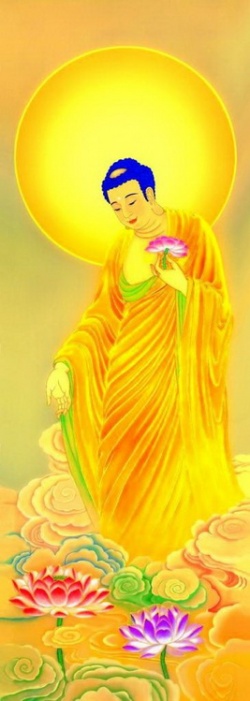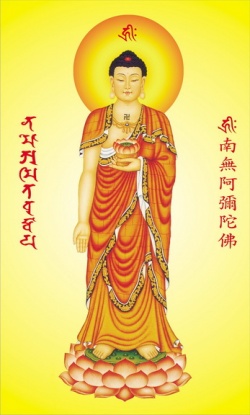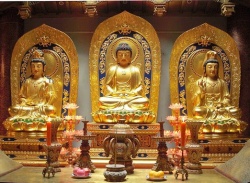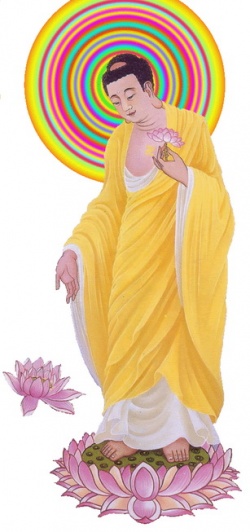Conceptions of the Absolute in Mahayana Buddhism and Shinran
by John Paraskevopoulos
A perennial problem for Buddhists has always been the question of how to articulate the relationship that obtains between the absolute and the relative orders of reality, ie. between Nirvana and Samsara. Although conceptions of Nirvana within the Buddhist tradition have changed over the centuries, it is safe to say that some of its features have remained constant throughout the doctrinal permutations of its different schools. Indeed some modern scholars of Buddhism in the West have even questioned whether it is meaningful to speak of an Absolute in Buddhism at all claiming that such a notion is an illegitimate transposition of certain 'substantialist' notions relating to the highest reality as found in its parent tradition, Hinduism. This paper will attempt to address the question of whether one can meaningfully speak of an Absolute in Buddhism, in what such a reality consists and what its implications are for understanding the highest goal of the Buddhist path. In doing this, I will be focusing chiefly on the Mahayana tradition and, in particular, on one of its principal metaphysical texts - The Awakening of Faith - in which we arguably find one of the most comprehensive treatments of the Ultimate Reality in the history of Buddhism. The paper will then address some of the implications of this discussion for understanding the Pure Land way and its consummation in the perspective of Shinran.
In one of his early seminal works on Buddhism 1, Edward Conze in discussing the question of whether early Buddhism can be considered atheistic, summarises the earlier, Hinayana view of Nirvana as follows:
We are told that Nirvana is permanent, stable, imperishable, immovable, ageless, deathless, unborn, and unbecome, that it is power, bliss and happiness, the secure refuge, the shelter, and the place of unassailable safety; that it is the real Truth and the supreme Reality; that it is the Good, the supreme goal and the one and only consummation of our life, the eternal, hidden and incomprehensible Peace.
which is to be contrasted to this world 'ie. everything conditioned and impermanent, which is emphatically regarded as wholly ill, as wholly pervaded with suffering, as something to be rejected totally, abandoned totally for the one goal of Nirvana'.2 In this sense, early Buddhism was radically dualistic in how it perceived these two realms - there was simply no connection between them. In other words, the individual can only attain Nirvana through the dissolution of this very individuality - hence the doctrine of anatman or 'not-self'. Furthermore, there was also the tendency to view Nirvana as more of a state of realisation than any kind of 'being' given the apophatic reticence of early Buddhism to commit itself to any definitive declarations regarding this ineffable reality and, to some extent at least, its conscious desire to demarcate itself from the metaphysics of the Upanishads. However, to what extent the polemics between these two camps was simply an outcome of a mutual misunderstanding over the meaning and implications of the concept of atman is a moot point that warrants an entire treatise in itself.
With the arising of the Mahayana as a discrete vehicle of the Dharma in its own right, one witnesses a growing tendency to universalise the concept of Buddhahood as a spiritual principle transcending the human personality of Shakyamuni and embodying a higher and permanent reality. Hence the concept of the 'eternal' Buddha which we see promulgated in such central scriptures as the Lotus Sutra and in such fundamental doctrines as that of the trikaya or the Three Bodies of the Buddha with the Dharmakaya (Body of Dharma) effectively becoming tantamount to the Buddhist Absolute. Other currents of thought within the Mahayana developed this notion further preferring to view Buddha or Nirvana as an all-pervasive reality embracing all things including the totality of samsara. In time, this growing tendency of attenuating the distinction between the two realms led eventually, especially in the Madhyamika school, to a full-blown identification which we find explicitly formulated in the famous dictum, 'Samsara is Nirvana'. From the fairly unqualified dualism of the Hinayana we now find a radical non-dualism at the apex of Mahayana thinking - and all this under the umbrella of 'Buddhism' ! Such a revolution in thinking appears to have no other precedent in religious history which clearly serves to demonstrate the complexity and controversy inherent in the tradition's struggle to understand the reality of enlightenment. However, to what extent we actually consider this development to be an innovative one largely depends on whether we believe that the origins of the Mahayana can be traced to the person of Shakyamuni himself. If, as has been suggested, the fundamental Mahayana tenets had already been adumbrated by the Buddha following his enlightenment and then subsequently disseminated by certain disciples through an oral tradition until such time as it was considered necessary to explain them in discursive mode through the written scriptures centuries later, then perhaps the Mahayanistic ontology can no longer be considered as radical as originally suggested but rather should be seen as a natural unfolding, over time, of what was taught by Shakyamuni from the beginning. This is doubtless a question which, although still subject to much controversy and obscurity, nevertheless offers much stimulating food for thought.
Having very briefly charted the rudimentary outlines of the transition from the early Buddhist view of Nirvana to the more developed and comprehensive conception of the Dharmakaya developed by the Mahayanists, let us know delve a little deeper in to the nature of this Absolute. In one of his earliest works, D.T.Suzuki quotes the following passage on the Dharmakaya from the great Avatamsaka Sutra:3
The Dharmakaya, though manifesting itself in the triple world, is free from impurities and desires. It unfolds itself here, there and everywhere responding to the call of karma. It is not an individual reality, it is not a false existence, but is universal and pure. It comes from nowhere, it goes to nowhere; it does not assert itself, nor is it subject to annihilation. It is forever serene and eternal. It is the One, devoid of all determinations. This body of Dharma has no boundary, no quarters, but is embodied in all bodies. Its freedom or spontaneity is incomprehensible, its spiritual presence in things corporeal is incomprehensible. All forms of corporeality are involved therein, it is able to create all things. Assuming any concrete material body as required by the nature and condition of karma, it illuminates all creations. Though it is the treasure of intelligence, it is void of particularity. There is no place in the universe where this Body does not prevail. The universe becomes but this Body forever remains. It is free from all opposites and contraries, yet it is working in all things to lead them to Nirvana.
At once, we see a more dynamic and all-encompassing view of ultimate reality possessed of personality, compassion and intelligence which takes the initiative in the liberation of sentient beings. This is in quite stark contrast to the Hinayanistic Nirvana which is more of a static, indifferent and dispassionate reality with no intimate connection to the world of birth-and-death. Nevertheless, both Buddhist traditions would agree that however conceived, Nirvana (which is really none other than the experiential dimension of the Dharmakaya) remains the ultimate goal of human endeavour and the only real source of human fulfilment and felicity. In any case, by personifying the Absolute and in forging a non-monastic path to its attainment, the Mahayana opened the gates of the Dharma to all people, especially the laity who had hitherto played a largely peripheral role in the spiritual life.
In many respects, the culmination of this cataphatic conception of the Absolute is to be found in a very short yet profoundly influential treatise known as the Awakening of Faith in the Mahayana traditionally attributed to Asvaghosha although only extant in Chinese. This work, which is often considered as a synthesis of the Madhyamika, Yogacara and Tathagata-garbha traditions, has exercised its influence on the founders of all the major schools of the Mahayana who have venerated the text as an unimpeachable authority on the questions with which it deals. In that respect, it serves as a very useful and reliable compendium of Mahayana metaphysics containing, as it does in a small but terse compass, a range of sophisticated and subtle teaching which one would only come across elsewhere by consulting numerous other sutras and shastras where the same points are often made only obliquely.
The fundamental standpoint of the Awakening of Faith is its belief in the Absolute which it calls 'Suchness' (tathata). As we have already seen, this reality has been called by many other names according to the perspective by which it is envisaged, viz. Dharmakaya, Nirvana, Buddha, Shunyata, Bodhi, etc. Now Suchness, the supreme reality according to this text, is both transcendent and immanent. In other words, it is completely beyond anything that we can imagine or conceive in our world of relativity and delusion with all its manifold limitations and yet, at the same time, it constitutes the very core of everything that exists - the deepest centre and 'Ultimate Source'4 of samsara itself. A corollary of this is to say that the Absolute, which is formless, manifests itself through forms which, although finite and limited, are none other than the Absolute of which they are its reflections. This is one way of understanding the meaning of 'Samsara is Nirvana'. It is not, of course, to say that they are identical but rather that they are ultimately non-dual. In this way, the world around us is then seen as an admixture of the conditioned and the unconditioned. The most illustrious master of the Hua-yen school, Fa-tsang, was a great devotee of the Awakening of Faith on which he has written the most authoritative commentary. His own thought was deeply influenced by this text as is evidenced by the following passage from Francis Cook's book on Hua-yen Buddhism which I cite for the purpose of clarifying what was said earlier about the relationship between samsara and Nirvana:
The very basis of Hua-yen thought seems to be a view of an Absolute which existed prior in time to a concrete world of things which it became. There it was said that any phenomenal object is a mixture of the True and the false, or the Unconditioned and conditioned (of course, the sum total of all things is this same mixture). Taking up the absolute side of things first, Fa-tsang says that it itself has two aspects. First, he says, it is immutable. This is not surprising because all religions claim immutability as the nature of the absolute. What kind of absolute would it be which changed like the ordinary things of the world ? Being immutable, the absolute is forever unmoved, pure, eternal, still and serene. This is, in fact, a common description of the absolute in all Mahayana forms of Buddhism. However, Fa-tsang next says something which not only seems to contradict this statement but which also is very unusual in Buddhism; he says that moved by certain conditions, this pure, unmoved eternal Reality changes and appears as the universe of phenomenal objects. However, like the gold which has become the ring, the immutable absolute remains the immutable absolute. Here the picture is apparently one of the emanation of the concrete universe from an immutable absolute with the result that things are a mixture of the absolute and the phenomenal.
I have quoted this passage at length to show the influence the Awakening of Faith had on a major school of Buddhism which although no longer extant continues to live through the doctrines and practices of the Zen school of which it is the intellectual complement. When Cook talks about this 'very unusual' statement by Fa-tsang he is referring to none other than the central thesis of the Awakening of Faith by which this eminent Hua-yen master was so greatly influenced. The important thing to note, however, is that it is not so much that this perspective is unusual as it is that it has been rendered so explicitly since it is a doctrinal position which must logically follow from the other fundamental tenets of Mahayana Buddhism.
Another distinctive feature of this text is its stress on the Absolute being both sunya ('empty') and a-sunya ('not empty'). Firstly, 'Suchness is empty because from the very beginning it has never been related to any defiled states of existence, it is free from all marks of individual distinction of things and it has nothing to do with thoughts conceived by a deluded mind.'6 Considered in this way, 'emptiness' should not be considered as 'non-existent' but simply (as Yoshito Hakeda, in his commentary, notes) 'devoid of a distinct, absolute, independent, permanent, individual entity or being as an irreducible component in a pluralistic world.....However, this negation does not exclude the possibility of Suchness being seen from a different viewpoint or order with which one is not accustomed. Hence, there is room to present Suchness, if it is done symbolically, as replete with attributes.'7 Asvaghosha, after pointing out that Suchness 'was not brought into existence in the beginning nor will it cease to be at the end of time; it is eternal through and through' goes on to say:
From the beginning, Suchness in its nature is fully provided with all excellent qualities; namely, it is endowed with the light of great wisdom, the qualities of illuminating the entire universe, of true cognition and mind pure in its self-nature; of eternity, bliss, Self and purity; of refreshing coolness, immutability and freedom....these qualities are not independent from the essence of Suchness and are suprarational attributes of Buddhahood. Since it is endowed completely with all these and is not lacking anything, it is called the tathagata-garbha (when latent) and also the Dharmakaya of the Tathagata....Though it has, in reality, all these excellent qualities, it does not have any characteristics of differentiation; it retains its identity and is of one flavour; Suchness is solely one....it is one without a Second.8
These are critical passages in helping us to understand the nature and function of Suchness. What we see is a concept of the Absolute as not only the fountainhead of all the happiness, joy and beauty of which we only experience the pale shadows in this world but the source of enlightenment and saving activity of all Buddhas and Bodhisattvas directed towards suffering sentient beings in samsara. It is therefore crucial to a proper understanding of Suchness not to view it under its other synonym, namely Emptiness or the Void, to mean a mere nullity or non-existence - this would be to fall prey to the pitfalls of nihilism against which the great Mahayana masters always warned us. To be sure, Suchness is not the kind of existence which can be considered analogous to the realities with which we are familiar in this fleeting world of ephemerality but rather is far more 'real' than anything within the purview of our limited empirical existence. There is a great danger, especially when one reads certain modern studies of Buddhism in the West, in failing to recognise that the notion of 'emptiness' about which one hears so much is not an emptiness or lack of reality as is sometimes curiously supposed but an emptiness of limitations, relativity and delusion. In this respect, emptiness serves as an upaya to help rid people of misguided and blinkered views of the highest reality rather than being some kind of comprehensive statement regarding it. One is inclined to consider the punishing dialectics of Nagarjuna and his Madhyamika system as simply a form of intellectual therapy designed to remove the obstacles to a clearer understanding of Suchness - breaking through the ratiocinative and conventional ways in which we artificially construct what we believe to be reality and to promote a more direct and intuitive mode of awareness through prajna or 'transcendental' wisdom. But such an exercise only stops half-way, otherwise the history of Buddhism would not have witnessed the rise of subsequent schools which endeavoured to fill the gaps, so to speak, left by the purely negative and apophatic approach of the sunyata perspective. There was a growing need for a more positive conception of the ultimate reality, a conception that addressed the fundamental needs of both the intelligence and the will in response to which arose, firstly, the Yogacara followed by the Tathagata-garbha schools of thought with their emphasis on the cataphatic dimension of the Absolute. Tantric Buddhism can also be considered a response to some of the perceived limitations with the early Madhyamika perspective. In any event, we now find a richer and complex ontology which sought to integrate existence in its entirety, and at all its levels, with Suchness. No dharma or element of existence was considered to be outside its embrace or influence such that all reality was suffused with the presence of the Buddha - a notion unthinkable to the Hinayana which was in no real position to reconcile this world of suffering and delusion with the realm which delivered one from all such sorrow. Nevertheless, despite the paradoxical nature of the Mahayana's preferred way of viewing the Absolute, it felt that its more difficult perspective was thoroughly justified in view of what it considered to be a deeper awareness of the omnipresent activity of Suchness in our everyday world of samsaric existence.
The rise of the Pure Land school of Mahayana Buddhism was largely contemporaneous with the flowering of the Mahayana itself and constituted one of its earliest manifestations. In one sense, it can be argued that the Pure Land way represented the most explicit example of the attempt to render the Buddhist Absolute as accessible as possible to ordinary people through the use of a wealth of rich and positive symbolism designed to heighten the aspiration for enlightenment. In this way, the Pure Land path can also be viewed as the best example of the a-sunya view of absolute reality, i.e. in contrast to the Madhyamikan view of Suchness as empty (sunya) or the 'Void', it is seen in its fullness and plenitude as the inexhaustible font of all merits, virtues, wisdom and compassion - an archetypal realm of perfection and beatitude. Hence the traditional descriptions of the Pure Land as being replete with the attributes of enlightenment through the evocative symbolism of jewels, music, colours, fragrances etc. By employing ostensibly sensual imagery, the sutras are attempting to convey, in terms that could be readily understood, a sense of the blissfulness of Nirvana - in contrast, no doubt, to the imperfection that afflicted the ordinary world-view of the average devotee. The Pure Land patriarch, T'an-luan, claimed that what distinguished Pure Land Buddhism from other schools is that the 'Dharmakaya of Dharma-nature' takes the initiative in relation to deluded and suffering beings manifesting itself as 'Dharmakaya of Expediency' in the form of various Buddhas, Bodhisattvas and Pure Lands. This is the ultimate act of compassion for without this initiative, ordinary beings would remain stranded in samsara with no hope of deliverance seeing as the clutches of ignorance and delusion in the Decadent Age of the Dharma were considered too strong to allow for individual effort and initiative to suffice for the attainment of enlightenment.
Although the Pure Land school claims the dynamic and compassionate nature of Suchness as a major advance in Mahayana thinking, it is possible to find the seeds of this conception in the Awakening of Faith itself in its doctrine of 'permeation' (vasana). Hence we find:9
The essence of Suchness is, from the beginningless beginning, endowed with the perfect state of purity. It is provided with suprarational functions and the nature of manifesting itself. Because of these two reasons, it permeates perpetually into ignorance. Through the force of this permeation, it induces a man to loathe the suffering of samsara, to seek bliss in Nirvana and, believing that he has the principle of Suchness within him, to make up his mind to exert himself.....The Buddhas and Bodhisattvas all desire to liberate all men, spontaneously permeating them with their spiritual influences and never forsaking them. Through the power of the wisdom which is one with Suchness, they manifest activities in response to the needs of men as they see and hear them.
This passage clearly shows the omnipresent activity of Suchness functioning as the immanent Absolute working in all things to bring them to enlightenment, to the extent that even an individual's aspiration to seek ([[[Buddha]]hood]] is brought about by the compassionate working of the Tathagatas irrespective of whether the aspirant is aware of this influence or not. In this respect, the 'self-power' and 'other-power' debate can be resolved if it is recognised that there is only one power - that of the Absolute - that pervades and supports all things and that one can either recognise and collaborate with it (which is to conform oneself to the Dharma) or allow it to operate unnoticed (which is to continue living in a state of nescience) - either way, the working of Suchness, according to the Mahayana, will eventually bring all sentient beings to nirvanic fulfilment as there is no thing which does not constitute the Body of Dharma (Dharmakaya) and is thereby not fully embraced by its wisdom and compassion.
Finally, I would like to give some brief consideration to the thought of |Shinran and his attempts to reconcile the traditional Pure Land teaching which he had inherited with the sapiential perspective of the Mahayana which he would have doubtlessly imbued as a Tendai monk for twenty years on Mt Hiei. The long-established view of the Pure Land school was that the principal object of devotion was not the formless Dharmakaya itself but the Buddha of Infinite Light (Amitabha) who had formerly been a bodhisattva called Dharmakara who, out of compassion for the multitudes of suffering sentient beings, underwent aeons of self-sacrificing practice and austerities which enabled him to accrue sufficient merit to attain ([[[Buddha]]hood]] and establish a Pure Land, over which he presides, and which provides aspirants with an ideal environment in which to pursue the Dharma and attain enlightenment. For a long time, Amitabha was recognised as one of one of many Buddhas existing throughout the universe each with their own pure lands which have been generated from their practices and vows. Devotion to Amitabha, however, was considered particularly efficacious owing to the fact that his vows were intended specifically for ordinary beings with little or no spiritual capacity whereas other Buddhas had established certain difficult preconditions for admission to their respective Pure Lands.
Shinran, while not explicitly repudiating this traditional view, chooses rather to universalise what he may have considered the mythological symbolism behind the Dharmakara story by grounding it in fundamental Mahayana principles - partly in order to address strong criticisms by other sects which considered the Pure Land way un-Buddhistic and partly, no doubt, because he had a profound awareness of a higher reality (which he often refers to as jinen or 'as-it-isness') which he saw as working in all things and manifesting itself through innumerable compassionate guises such as Amitabha's Vows and his Pure Land. For Shinran, jinen signifies that which is beyond form and time and beyond the domain of human intellect and will. It is the Dharma-body as Suchness which 'fills the hearts and minds of the ocean of all beings'.10 In one of his famous letters, Shinran makes the following observation:11
The Supreme Buddha is formless and because of being formless is called 'jinen'. When this Buddha is shown as being with form, it is not called the supreme nirvana (Buddha). In order to make us realize that the true Buddha is formless, it is expressly called Amida Buddha; so I have been taught. Amida Buddha is the medium through which we are made to realize 'jinen'.
This passage was written towards the end of Shinran's life and signals a radical attitude in thinking about the Buddha within the Pure Land tradition. It is as if Shinran has stripped the complex and rich edifice of Pure Land spirituality down to its bare principles. This, however, is not reductionism on Shinran's part but an attempt to rehabilitate the 'wisdom' aspect of the Mahayana which was in danger of possibly being overlooked by the rich upayas offered by the great message of compassion which, in many ways, formed the centrepiece of the Pure Land message. One also finds in Shinran, and to a far greater extent than his own illustrious teacher Honen, a deep appreciation of the multifaceted nature of Nirvana and its activity:12
Nirvana has innumerable names. It is impossible to give them in detail; I will list only a few. Nirvana is called extinction of passions, the uncreated, peaceful happiness, eternal bliss, true reality, Dharmakaya, dharma-nature, Suchness, oneness and Buddha-nature. Buddha-nature is none other than Tathagata. This Tathagata pervades the countless worlds; it fills the hearts and minds of the ocean of all beings. Thus, plants, trees and land all attain Buddhahood. Since it is with these hearts and minds of all sentient beings that they entrust themselves to the Vow of the dharma-body as compassionate means, this shinjin is none other than Buddha-nature. This Buddha-nature is dharma-nature. Dharma-nature is the Dharmakaya.
Shinran here is advocating a broader grasp of Nirvana than we see in any of his predecessors even though he was greatly influenced by them (especially T'an-luan) in arriving at his developed position. Amitabha, therefore, becomes the compassionate personification of Suchness itself and not the outcome of the innumerable practices of a particular quasi-historical individual over many kalpas. Even Dharmakara himself, according to Shinran, emerges from the 'ocean of Suchness' to make known the vows of the Buddha of Infinite Light through the sutras of the Pure Land school. Furthermore, he takes the radical step of equating the Pure Land with Nirvana itself rather than treating it as a more favourable abode for Buddhist practice, so that to attain birth in the Pure Land is tantamount to attaining enlightenment. Similarly, in relation to the central experience of the religious life according to Shinran, ie. shinjin, we no longer find just a rudimentary faith in the Buddha and his power to save but a recognition that this very experience has its source in the very heart of reality itself - another way of saying that awareness of the Buddha's working through the experience of shinjin is none other than the activity of the Buddha himself in sentient beings.
The influence of T'an-luan on Shinran's thought cannot be underestimated and, indeed, was critically seminal in shaping the latter's mature position in relation to these questions. In fact, one could argue for a doctrinal lineage of transmission commencing with Asvaghosha and running through Nagarjuna, Vasubandhu and T'an-luan leading finally to Shinran himself. The profound influence of T'an-luan can readily be seen in the numerous passages which Shinran quotes from the Commentary on Vasubandhu's Discourse on the Pure Land a work of inestimable significance in the Pure Land tradition. In it, we find the genesis of many important ideas that have formed the hallmark of this tradition. For example, it is in T'an-luan that we first find mention of the two kinds of Dharmakaya referred to earlier as well as the philosophical justification behind the idea that the Name of the Buddha contains all the merits and virtues of Suchness by distinguishing those names that stand for things and those names (ie. of Buddhas and Bodhisattvas) that are identical with the realities to which they refer. The latter, in particular, was instrumental in helping Shinran to formulate his position on the significance of Amida's Name and nembutsu practice. In his Hymns on the Patriarchs, we find the passage13:
The Name of the Tathagata of Unhindered Light
And the Light that is the embodiment of Wisdom
Dispel the darkness of the long night of ignorance
And fulfill the aspirations of sentient beings
and in his Notes on 'Essentials of Faith Alone', we find14:
The sacred name of Amida surpasses measure, description and conceptual understanding; it is the Name of the Vow embodying great love and great compassion, which brings all sentient beings into the supreme nirvana....the Name spreads universally throughout the worlds in the ten quarters, countless as minute particles, and guides all to the practice of the Buddha's teaching.
It is clear that Shinran envisaged the Name to possess all the qualities of enlightenment itself - the perfect form taken by the formless Buddha in order to make itself known and realised by sentient beings.
Shinran was very conscious not to be seen as indulging in unorthodox innovations which is why he goes to such pains to cite authoritative scriptures in support of his views. On the one hand, he needed to convince the other Mahayana sects that his teaching was not an aberration of the Dharma and, on the other, he had to assure those within the Pure Land tradition that he was not being unfaithful to its perspective either. The extent to which he succeeded in accomplishing this difficult and challenging task is evidenced by the extraordinary flourishing of Jodo Shinshu over the past seven hundred years. One of the principal texts that Shinran used in support of his views regarding the ultimate reality was the famous Nirvana Sutra which he practically quotes in its entirety in his magnum opus, Kyogyoshinsho. In order to reinforce my point about the unanimity between Shinran and the great Mahayana metaphysical tradition which he deeply venerated, I would just like, in conclusion, to quote a few important passages15 from the Nirvana [[]]Sutra which Shinran cites with approval in the Kyogyoshinsho to show that not only is Shinran thoroughly Mahayanistic in his view of the Absolute but that he accomplished a wonderful synthesis between the respective demands of wisdom and compassion in his propagation of the Pure Land faith:
Tathagata is also thus - nonarising, nonperishing, unaging, undying, indestructible and incorruptible; it is not a created existence....All created things are impermanent....Buddha nature is the uncreated; hence it is eternal.
The Tathagatas are eternal and never changing; hence they are termed true reality.
Although sentient beings are impermanent, still their Buddha-nature is eternal and unchanging.
The dharma-body (of the Tathagata) is eternity, bliss, self and purity.
In closing, I would like to reiterate the great importance of an adequate and satisfying conception of the Absolute as being indispensable to the Buddhist path. In a climate of increasing scepticism and reductionism, especially in certain Buddhist scholarly circles in the West, it is imperative that one does not lose sight of the fact that without such concepts as Dharmakaya, Suchness, Nirvana, Sunyata etc. being grounded in a true and existing reality which both transcends and suffuses all things, Buddhism is left without any foundations and stands on nothing, thereby losing all sapiential and soteriological efficacy. In the attempt by some to make Buddhism more fashionable by denying that it has anything much in common with views of ultimate reality in other spiritual traditions, it does itself a great disservice in failing to recognise clear parallels where they exist - parallels, indeed, which should not surprise anyone. To speak of all these terms to describe the Absolute as 'symbolic' in an attempt to somehow downgrade the reality of the ultimate object of aspiration is sheer folly - of what exactly are they symbols ? To be sure, these terms do not exhaust the fathomless depth of the reality to which they refer but, on the other hand, neither are they empty symbols created by us in order to fulfill some kind of nostalgic and delusory quest for the Infinite which has no basis in the true nature of things. A spiritual path which cannot offer any deliverance from that which is finite, imperfect and illusory, to that which affords eternal blessedness and liberation from suffering and the painful clutches of samsaric existence, is simply not worthy of the name.
Notes:
1. Edward Conze, Buddhism: its essence and development (Harper & Row 1975), p.40.
2. Conze, p.21
3. D.T.Suzuki, Outlines of Mahayana Buddhism (Schocken: New York 1963), pp. 223-224.
4. The Awakening of Faith: Attributed to Asvaghosha - translated, with commentary, by Yoshito S. Hakeda (Columbia University Press: New York 1967), p.92.
5. Francis H. Cook, Hua-yen Buddhism: The Jewel Net of Indra (Pennsylvania State University 1977), p.94.
6. Hakeda, p.34.
7. Hakeda, p.36.
8. Hakeda, p.65.
9. Hakeda, p.59 & p.63.
10. The Collected Works of Shinran: Volume II (Jodo Shinshu Hongwanji-ha 1997), p.191
11. Letters of Shinran: A Translation of Mattosho, Shin Buddhism Translation Series, ed. Yoshifumi Ueda (Hongwanji International Centre: Kyoto 1978), p.30.
12. The Collected Works of Shinran: Volume I (Jodo Shinshu Hongwanji-ha 1997), p.461
13. Collected Works: Volume I, p.373.
14. Collected Works: Volume I, p.452.
15. Collected Works: Volume I, p.181, p.184, p. 185 & p.188.









